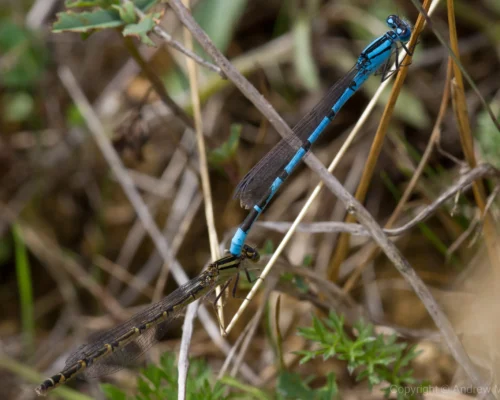Reproduction in dragonflies and damselflies
The primary goal for Odonata is to reproduce and ensure their genes are passed to a new generation; how dragonflies and damselflies reproduce is unique in the animal kingdom.
The male has two distinct sets of reproductive organs: one is for sperm production and the other for insemination of the female; there is no connection between the two. The male produces sperm near the tip of the abdomen, in segment 9. Before fertilisation can take place, the male must first transfer sperm to a set of Secondary Genitalia situated at the opposite end of the abdomen, closer to the head, in segment 3 of dragonflies and segment 2 of damselflies. Male dragonflies perform this sperm transfer before engaging with a female, but in damselflies this is done once in ‘Tandem’.
Because of this, reproduction is not performed with abdomens ‘tip to tip’ as with other insects, and the female must connect her ninth segment to the male’s second or third segment to fertilise her eggs, aligning themselves in a so called ‘wheel’ posture.
Dragonflies and damselflies have evolved complicated strategies for finding or attracting a mate; males are usually more brightly coloured than females, the more subdued colouring of the female is perhaps advantageous in camouflaging their egg-laying activities where they become more vulnerable to predators. Some species, like the Banded Demoiselle – Calopteryx splendens, exhibit complex courtship rituals which can be fascinating to watch as they display along the river’s edge. Males of many dragonfly species are very territorial, tenaciously chasing off other Odonata with seemingly endless energy, in search of a suitable mate. Male damselflies are typically not as territorial as male dragonflies, and it is common to see large numbers of males congregating at a suitable site in search of a mate.
Breeding however places a heavy resource burden on dragonflies and damselflies, and they must feed often to ensure they have energy and materials to breed before their relatively short life is over. This means that for an individual breeding might not occur every day, and some days might be thought of as ‘rest days’. Females approach water to breed less often, while their bodies recuperate and produce more eggs.
Copulation
The male abdomen has specialised Anal Appendages at the tip, used as claspers to capture and hold the female in the ‘Tandem’ posture. In dragonflies, the female is held by the head, while damselfly females are held by the Pronotum, a shield-like plate located just behind the head. The shape of the claspers and pronotum are unique to each species, so helping avoid interspecies hybridisation – mistakes can occur however where similar species are found in the same area and seems more common in Emerald/Willow Emerald Damselfly species, where there are reports of mixed pairings.
Prior to copulation, the male must perform the sperm transfer. In dragonflies this takes place before the male engages with a female, but in damselflies this is done once the pair are in ‘Tandem’, immediately before copulation takes place.
With the female held by his claspers, the male flexes his abdomen underneath him, facilitating the connection of the female segment 8 to the male segment 2 or 3, fertilising the eggs with sperm.
Dragonflies and damselflies may often be seen in tandem and wheel postures (‘in cop’), either at rest or flying. Some species like the Blue-tailed Damselfly – Ischnura elegans may remain coupled this way for several hours, but in species such as Broad-bodied Chaser – Libellula depressa copulation lasts only seconds and is done on the wing.
Egg laying – Ovipositing
Damselflies usually remain in tandem or with the male close by, while the female lays, or Oviposits, her eggs. In some dragonfly species such as hawkers, the female lays her eggs completely alone, but others remain in tandem similar to damselflies. There is no internal gestation period, and fertilised eggs are oviposited immediately following copulation. Eggs are laid in or close to water, and the female may oviposit hundreds or thousands of eggs after successful breeding.
There are three distinct methods used by dragonflies and damselflies while ovipositing, each species relies on one method.
Exophytic ovipositors
Species that deposit their eggs in water are known as Exophytic ovipositors, the eggs sink to the bottom to eventually hatch in the sediments below. Darter and Chaser species do this in flight, and dip their abdomen into the water repeatedly, releasing eggs each time. In some species the female does this alone, but others stay in tandem. In tandem ovipositing the pair fly close over the water’s surface together. With remarkable control and synchronised precision, the male ‘flicks’ the female, dipping the tip of her abdomen below the water as she releases her eggs.
Epiphytic ovipositors
Some dragonfly species deposit eggs directly on the surface of floating or submerged vegetation. These are Epiphytic ovipositors; it is a less commonly used method presumably because it offers less protection to the eggs from predators than other means of oviposition.
Endophytic ovipositors
Some species inject their eggs directly into floating or submerged plants, or other substrates like mud or rotting wood. These are Endophytic ovipositors and include Hawker dragonflies and all damselflies. Emergent bankside plant and reed stems above the water line may also be used. Species like the Willow Emerald – Chalcolestes viridis oviposit into the bark of tree branches that overhang water, and the resultant larvae drop in to the water below when they hatch.
Some damselflies may completely submerge underwater for minutes at a time to find the most suitable location to lay their eggs. The male remains in tandem with the female and will assist in breaking free of the water’s surface tension to take to the air again.
Eggs hatch usually after a few weeks, but this is climate dependant, and in some species, eggs overwinter and will hatch the following spring.







